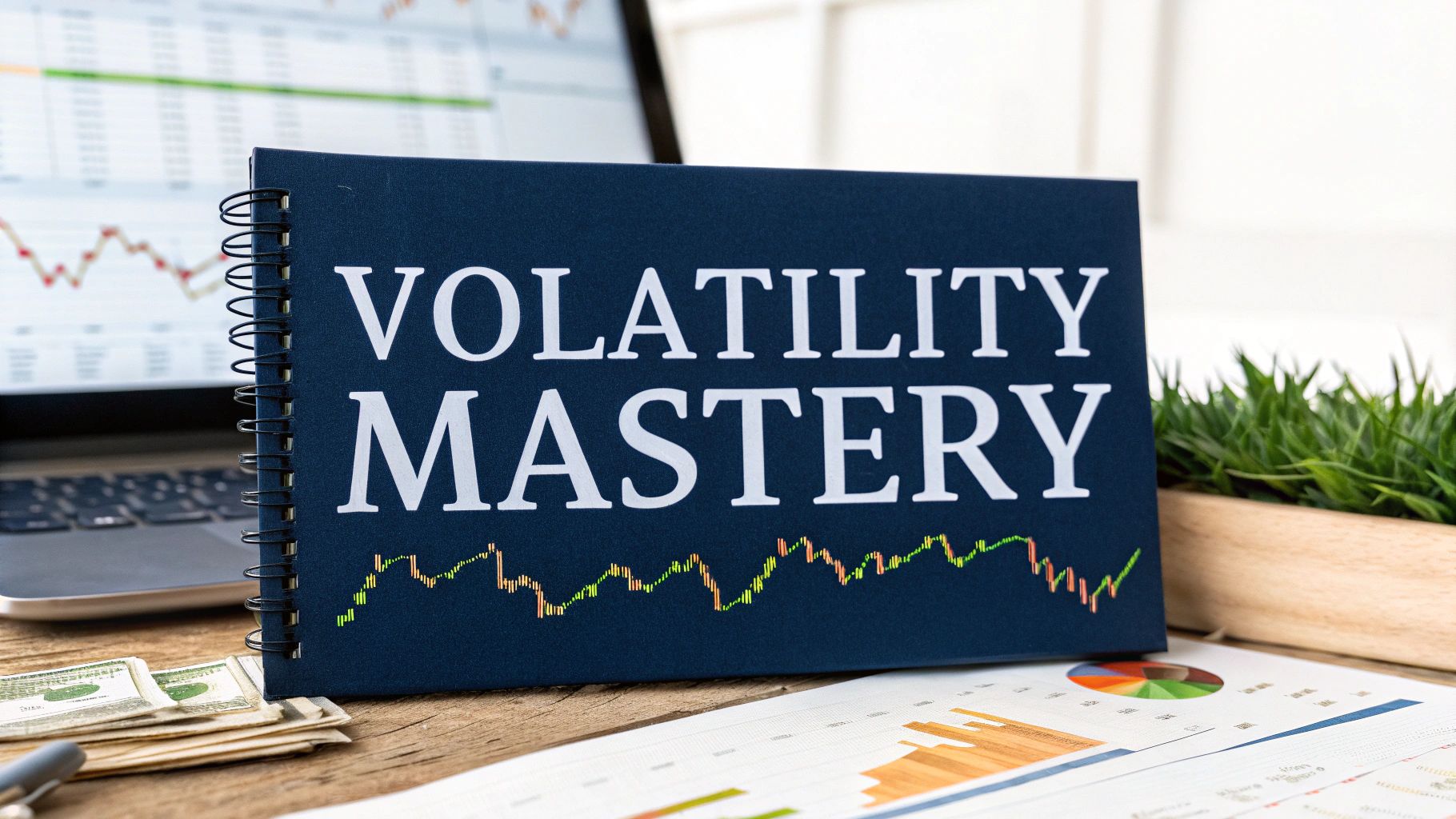Breaking Down Implied Volatility Essentials
If you trade options regularly, understanding implied volatility is essential for making informed decisions. Unlike historical volatility that looks backward at past price movements, implied volatility shows what the market expects about future price changes for an asset. This forward-looking nature makes it an invaluable tool for traders who want to anticipate where prices might go next.
What Does Implied Volatility Actually Tell Us?
At its core, implied volatility acts as a measure of expected market movement. When implied volatility is high, traders expect bigger price swings ahead. When it's low, they expect more stable prices. For example, if a stock option has 30% implied volatility, this doesn't mean the stock will move exactly 30%. Instead, it suggests there's a 68% chance the stock price will stay within a certain range during the option's lifetime. For a $100 stock, 30% implied volatility means the price is expected to stay between about $70 and $130 most of the time.
This information helps options traders determine if option contracts are expensive or cheap compared to their potential value. They regularly compare current implied volatility levels to past volatility and their own analysis of where volatility might go next.
How Do Professional Traders Use Implied Volatility?
Professional traders put implied volatility to work in practical ways. When they see unusually high implied volatility, they often sell options, expecting volatility levels to fall back to normal over time – similar to selling an overpriced stock. On the flip side, when implied volatility is unusually low, they might buy options, betting that volatility will increase and boost option values.
Implied volatility also helps traders prepare for major market events. Take earnings announcements – if implied volatility suddenly jumps before a company reports earnings, it signals that traders expect a big price move afterward. Smart traders use this information to position themselves for potential big swings, even if they're not sure which direction the price will go.
The Interplay of Implied Volatility and Options Pricing
Options prices move up and down with implied volatility. Higher implied volatility pushes option prices higher because there's a better chance the option could become profitable. Lower implied volatility means lower option prices. This relationship gives traders more ways to profit. For instance, some traders use calendar spreads – they sell short-term options when implied volatility is high while buying longer-term options when implied volatility is lower. The goal is to profit both from time decay on the short-term option and from any drop in volatility. Success in options trading comes down to understanding these connections between implied volatility and option prices, then using that knowledge to spot good trading opportunities.
Mastering Historical and Implied Volatility Analysis

To trade options effectively, you need to understand two key metrics: historical and implied volatility. While these measures are connected, they tell different stories about price movements that can help you find good trading opportunities. Let's look at how experienced traders use both to make better decisions.
Understanding the Relationship Between Historical and Implied Volatility
Historical volatility gives us concrete data about how much an asset's price has moved in the past. For instance, when we see a historical volatility of 25% over 180 days, it means the asset's price typically moved up or down by about 25% annually during that time. This helps establish a baseline for normal price movement, though we should remember that past patterns don't guarantee future behavior. That's where implied volatility comes in.
Options implied volatility shows us what the market thinks will happen next. It's calculated from current option prices and represents the market's best guess about future price swings. For example, if implied volatility is 20%, the market expects prices to move roughly 20% over the next year. This forward-looking measure is particularly important for options traders since it directly affects option prices.
Identifying Divergences and Opportunities
Smart traders watch for gaps between historical and implied volatility, as these differences often point to trading opportunities. By comparing what has actually happened (historical volatility) with what traders expect (implied volatility), you can spot options that may be mispriced.
For instance, when historical volatility runs low but implied volatility is high, the market might be overestimating future price swings. This could be a good time to sell options and profit from inflated premiums. On the flip side, if historical volatility is high while implied volatility stays low, the market might be underestimating future moves – creating a chance to buy options cheaply.
Utilizing Multiple Time Frames for Analysis
Top traders don't just look at one time period – they analyze volatility across different spans. Short-term analysis (like 10-day periods) can reveal quick trading opportunities, while longer views (like 180 days) show the bigger picture of how volatile an asset typically is. When short-term volatility differs significantly from long-term patterns, it often suggests prices might return to their usual range.
Considering Market Context
Numbers alone don't tell the whole story – you need to consider what's happening in the market. Important events like earnings reports, economic news, or major world events can cause big shifts in both historical and implied volatility. An upcoming earnings announcement might push implied volatility higher even if historical volatility has been quiet. By looking at volatility metrics alongside market events and conditions, traders get a clearer picture that helps them make smarter choices about when and how to trade.
Profiting from Market Events and Volatility Shifts
Smart traders know that market-moving events create clear patterns in volatility that they can use to their advantage. By understanding how volatility typically behaves before and after major events, you can spot high-probability trading opportunities. Let's explore how to identify and profit from these predictable volatility shifts.
Earnings Announcements: A Prime Example
Take earnings announcements – they show this pattern perfectly. Before a company reports earnings, traders aren't sure if the news will be good or bad, just that the stock is likely to move significantly. This uncertainty drives up options implied volatility. For instance, if a stock usually moves 5% after earnings, implied volatility might price in a 7-8% move beforehand. Once the news comes out, volatility typically drops sharply as uncertainty resolves. These reliable patterns give traders clear entry and exit points.
Economic Releases and Major Market Events: Further Opportunities
This same dynamic plays out with other market-moving news. Monthly jobs reports, Federal Reserve meetings, and unexpected events like geopolitical developments all impact market volatility in observable ways. Experienced traders track these events carefully and plan their positions around them. A big upcoming Fed announcement, for example, often leads to rising volatility across the whole market as traders brace for potential policy changes.
Strategies for Navigating Volatility Shifts
Traders use several proven strategies to profit from event-driven volatility changes:
- Straddles and Strangles: Buying both calls and puts lets you profit from big moves in either direction after major news
- Iron Condors and Butterflies: These spreads make money when volatility falls after an event resolves
- Calendar Spreads: Trading options with different expiration dates helps capture the varying effects of time decay and volatility changes
These are common approaches, but you'll want to adapt them based on your market view and comfort with risk.
Managing Risk During Volatile Periods
Of course, trading around market events requires careful risk management. Use stop losses to protect against adverse moves. Keep position sizes reasonable so no single trade can seriously damage your account. Success comes from combining your knowledge of volatility patterns with disciplined risk controls. This balanced approach helps you capitalize on volatility while keeping downsides contained.
Building Your Volatility Trading Arsenal

Knowing how to read implied volatility sets the foundation, but the real skill comes from turning that knowledge into profitable trades. Smart traders develop specific strategies to capitalize on volatility movements in both directions. This means having clear rules for entering and exiting trades, while staying flexible enough to adjust as market conditions change.
Constructing Trades for High Options Implied Volatility
When implied volatility runs high, it signals that traders expect big price swings ahead. This creates perfect conditions for strategies that profit when volatility eventually cools down. One effective approach is selling short-term options that command high premiums during volatile periods. As volatility settles back to normal levels, these options typically lose value, letting you buy them back cheaper for a profit.
- Iron Condors: This strategy combines selling both put and call spreads to create a specific profit zone. You make money when the stock price stays within your chosen range and volatility drops, reducing the value of options you sold.
- Short Straddles/Strangles: With short straddles, you sell both calls and puts at the same strike price and expiration. Strangles use different strike prices but follow the same principle. Both methods work best when volatility falls and prices move less than expected.
Capitalizing on Low Options Implied Volatility
When implied volatility sits at low levels, the market expects calm waters ahead. This sets up opportunities for strategies that benefit when volatility picks up. The key is spotting situations where prices might move more than the market expects.
- Long Straddles/Strangles: Buying straddles or strangles lets you profit from big moves up or down. These strategies cost less when volatility is low, making them attractive bets on future price swings.
- Calendar Spreads: This approach involves buying longer-dated options while selling shorter-term ones on the same stock. When volatility is low, you can buy the longer options cheaply. The shorter options you sell decay faster, potentially leading to profits if volatility increases.
Adapting to Market Conditions and Managing Risk
Good volatility trading requires flexibility, not rigid adherence to one approach. Traders need to read market signals and adjust accordingly. For example, you might switch from selling iron condors during high volatility to buying calendar spreads when volatility drops unusually low. Or you may need to quickly reduce positions if unexpected news creates market uncertainty.
Risk management must stay top of mind through all market conditions. This includes careful position sizing, setting clear stop losses, and spreading risk across different stocks and strategies. Smart risk management helps protect your trading capital and builds consistent returns over time. Remember – even the best volatility strategies need solid risk controls to succeed long-term.
Advanced Volatility Trading Techniques
To become better at trading options, you need to look beyond basic implied volatility concepts and learn the advanced analysis methods used by professional traders. This includes studying volatility skew, term structure, and the full volatility surface to find opportunities that others miss. Let's explore how these key techniques can give you deeper insights for smarter trading decisions.
Understanding Volatility Skew
When you look at options with the same expiration date but different strike prices, you'll notice their implied volatilities aren't equal – this difference is called volatility skew. Think of it as the market's way of pricing different odds for various price movements. In stock markets, you'll often see put skew, where out-of-the-money puts have higher implied volatility than out-of-the-money calls. This happens because investors buy more puts for protection against market drops, pushing up their prices and implied volatility. The opposite pattern, call skew, suggests markets expect bigger upward moves. Smart traders use these skew patterns to build strategies. For example, if you think the skew will flatten out, you might sell options where the skew is steep and buy where it's flatter, aiming to profit from that change.
Analyzing the Term Structure of Volatility
Term structure shows you how implied volatility changes across different expiration dates. Picture a chart with implied volatility on one axis and time until expiration on the other. Usually, you'll see higher volatility in short-term options that drops off for longer dates. But this pattern can shift dramatically around key events like earnings reports or Fed meetings. Short-term option volatility often jumps before these events as traders factor in uncertainty, then falls sharply after the news comes out. By tracking these term structure changes, you can spot good times to use calendar spreads – strategies that profit when implied volatility differs between expiration dates.
Navigating the Volatility Surface
When you combine skew and term structure, you get the volatility surface – a 3D view showing how implied volatility moves across both strike prices and expiration dates. This fuller picture helps you spot unusual patterns and potential mispricing in the options market. It's especially useful for diagonal spreads, where you trade options with different strikes and expiration dates. For instance, you might notice implied volatility looks unusually high in one area of the surface and sell options there, expecting volatility to return to normal levels. With practice reading the volatility surface, you can build strategies that profit not just from price movement, but from changes in implied volatility itself. This deeper understanding of how different volatility factors interact opens up more ways to find profitable trades.
Risk Management Mastery for Volatility Traders

Success in options trading, particularly when focusing on volatility strategies, depends heavily on solid risk management practices. Like a skilled ship captain navigating rough waters, traders need to know how to protect their capital during market turbulence while still capturing profitable opportunities. Let's explore the key risk management techniques that successful volatility traders use to stay profitable over the long run.
Position Sizing: The Cornerstone of Risk Management
Smart position sizing is essential for lasting success in options trading. Think of it as portion control for your trading capital – you need to size each trade appropriately so that no single loss can seriously damage your portfolio. Many experienced traders follow the 1-2% rule, limiting risk on any single trade to no more than 1-2% of their total capital. For instance, with a $100,000 account, you'd risk at most $1,000-$2,000 per trade. This principle becomes especially important when trading around high-volatility events that can cause big price swings.
Stop-Loss Strategies: Protecting Against Adverse Moves
Stop-loss orders work like a safety net for your trades. By automatically closing positions when they move against you by a set amount, these orders help limit potential losses. For example, if you buy a call option for $5, setting a stop-loss at $4 means your position will close if the option price drops to that level. Keep in mind though – while stop-losses are valuable tools, they aren't perfect, especially in fast markets where prices can jump past your stop level.
Portfolio Diversification: Spreading the Risk
Just as you wouldn't put all your eggs in one basket, smart traders spread their risk across different investments. This means trading options on various underlying assets, using different strategies, and choosing multiple expiration dates. For example, rather than focusing solely on tech stock options, you might trade options on stocks from different sectors, or even different asset types. You can also balance your portfolio by mixing strategies that profit from both rising and falling volatility.
Understanding Market Environment and Volatility Conditions
The market environment greatly influences options trading success. During uncertain times, options tend to become more expensive as implied volatility rises, creating both bigger opportunities and risks. Smart traders often reduce their exposure in these conditions or look for ways to profit from volatility dropping back to normal levels. In calmer markets with low volatility, they might increase their position sizes or focus on strategies that benefit when volatility picks up.
Learning from Professional Traders
One of the best ways to improve your risk management skills is to study successful volatility traders. By examining how they handle position sizing, implement stop-losses, and structure their portfolios, you can learn valuable lessons about protecting capital in volatile markets. This could mean reading trader interviews, joining trading communities, or attending educational sessions focused on options trading.
Boost your options trading returns and manage risk effectively with Coverd. Turn hours of tedious research into actionable insights in seconds. Coverd helps you effortlessly manage covered calls and cash-secured puts, optimizing your portfolio performance. Learn more at https://coverd.io

Leave a Reply